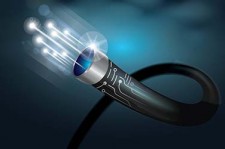Fiber Optics Turn 50 Just as 5G Arrives

WELLESLEY, Mass., June 22, 2020 (Newswire.com) - 5G will be 100 times faster than 4G, according to the latest report by BCC Research, 5G Services in North America.
It is both good and bad news that 5G will be adopted at a ferocious pace. With 20 billion devices in hand and eager for it, we will seamlessly transfer to these higher speeds, and that’s good news. Less good is that entrepreneurs, industries, governments and scientists are going to come up with ways to use far more of it, at exponential rates.
Light has unlimited capacity—but the medium carrying and directing it does not. For 50 years the major medium in optical fibers has been silica (silicon dioxide, naturally occurring as quartz), and so far, it has held up. In this major anniversary of the technology, we look ahead and wonder—will it still be the material of choice for 5G and everything beyond?
Report Highlights
- In North America, 5G services will experience good growth, which will create intense competition. To launch 5G commercially, all the major telecom service providers across the U.S. and Canada are moving aggressively.
- It is estimated that there are plans to invest more than $275 billion in network infrastructure projects in North America, including in 5G, all of which will boost the U.S. GDP.
- IoT is a developing technology that is expected to significantly impact the growth of 5G applications. It is expected that there will be more than 3.6 billion additional IoT connections in North America by 2025.
Read the full report here: https://corporate.bccresearch.com/market-research/information-technology/north-america-5g-services-market-report.html
“I do not think that silica is likely to be replaced in conventional fibers by any other material,” said Sir David Payne (CBE FRS FREng), Director of the Optoelectronics Research Centre at the University of Southampton, UK.
“However, there is a way to make optical fibers that are insensitive to the characteristics of the materials from which they are made. That is to use air as the transmission medium within a so-called hollow-core fiber. The latest result from the Southampton University labs is 0.28dB/km, a startling result that is within a factor of two of conventional fiber losses. So, we are within striking distance of beating standard fiber, with the added advantage of near zero scattering and nonlinearity, low latency and with high power handling and radiation hardness thrown in. For IR fiber transmission where material losses are dominant, there is a real opportunity.”
About BCC Research
BCC Research publishes market research reports that provide organizations with intelligence to drive smart business decisions. By partnering with industry experts worldwide, BCC Research provides unbiased measurements and assessments of global markets covering current and emerging industrial and technology sectors. For more information about BCC Research, visit bccresearch.com.
Source: BCC Research
